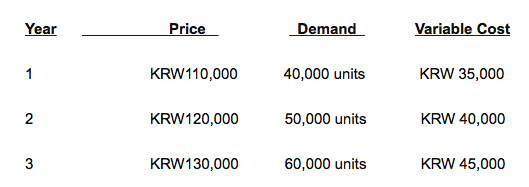Question
A project in South Korea requires an initial investment of 2 billion South Korean won (KRW). In addition to the initial investment for an equipment,
A project in South Korea requires an initial investment of 2 billion South Korean won (KRW). In addition to the initial investment for an equipment, KRW 50 million is needed for additional working capital and will be recovered at the end of the project. The Korean subsidiary will borrow the KRW 50 million and pay interest only on the loan each year, at an interest rate of 12 percent. The loan principal is to be paid in 10 years.
The project will be terminated at the end of Year 3, when the subsidiary will be sold.
The price, demand, and variable cost of the product in South Korea are as follows:

The fixed costs, such as overhead expenses, are estimated to be KRW 60 million per year.
The Korean government will impose a corporate income tax of 30 percent on income. In addition, it will impose a withholding tax of 10 percent on earnings remitted by the subsidiary. The U.S. government will allow a tax credit on the remitted earnings and will not impose any additional taxes.
All cash flows received by the subsidiary are to be sent to the parent at the end of each year. The subsidiary will use its working capital to support ongoing operations.
The equipment is depreciated to zero over 10 years using the straight?linedepreciation method. In three years, the subsidiary is to be sold. The company plans to let the acquiring firm assume the existing loan in Korean won. The company expects to receive KRW 200 million after subtracting capital gains taxes. Assume that this amount is not subject to a withholding tax.
The company requires a 12 percent rate of return on this project. The current value of the dollar is 1,085 won per U.S. dollar, and the expected value of the dollar would be 1,055 won, 1,030 won, and 1,015 won respectively at the end of year 1, 2, and 3.
--------------------------------------------------------------------------------------------------------------------------------------
a. Determine the net present value of this project. Should the company accept this project?
--------------------------------------------------------------------------------------------------------------------------------------b. Assume that the company is also considering an alternative financing arrangement, in which the parent would provide financing in US dollars to cover the working capital requirements so that the subsidiary would avoid Korean won. If this arrangement is used, the selling price of the subsidiary (after subtracting any capital gains taxes) is expected to be KRW 300 million. Is this alternative financing arrangement more feasible for the parent than the original proposal? Recalculate the net present value of the project and explain.
--------------------------------------------------------------------------------------------------------------------------------------
c. Assume the company used the original financing proposal and that funds are blocked until the subsidiary is sold. The funds to be remitted are reinvested at a rate of 6 percent (after taxes) until the end of Year 3. How will the projects NPV be affected? Recalculate NPV (show your calculation).
Step by Step Solution
There are 3 Steps involved in it
Step: 1

Get Instant Access to Expert-Tailored Solutions
See step-by-step solutions with expert insights and AI powered tools for academic success
Step: 2

Step: 3

Ace Your Homework with AI
Get the answers you need in no time with our AI-driven, step-by-step assistance
Get Started


